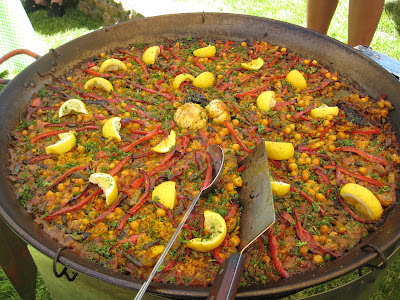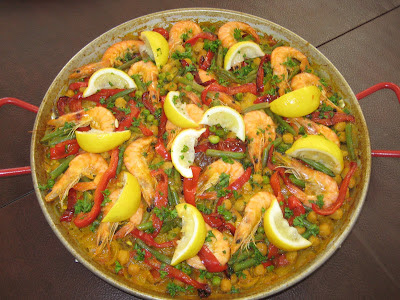
|
| Authentic Seafood Paella |
Because paella is one of my favorite dishes, I sought a way to learn how to make a good paella. I first heard about Gerard Nebesky (chef and owner of Gerard's Paella) when he was challenged by Bobby Flay (a Food Network chef known for his Southwest cooking) in a paella throwdown (season 5, episode 4: watch the full episode above to see who prevails). FYI, one of the judges for this competition was none other than local B44 chef Daniel Oliveira who is also known for making a few paellas here and there. Gerard is known locally in Sonoma County (ie Healdsburg, Occidental, etc) which is just north of the San Francisco Bay Area for making very good paella with his gigantic paella pans at various festivals (Eat Real Festival in Oakland's Jack London Square, Maker Faire, Hardly Strictly Bluegrass, etc.) and other outdoor events - he even catered Teri Hatcher's 40th birthday party with savory paella for all her guests. I was lucky enough to take a class taught by Gerard himself. The class was held at a local winery in Healdsburg, CA. Gerard is probably one of the nicest people you'd ever meet. In addition to teaching us how to make paella (see the recipe), Gerard shared some of his experiences traveling and making paella in various parts of the world. If you ever want to meet Gerard serving his delicious paella to the masses or you just want to drop by and say hello, you can find him at the Occidental farmer's market Friday afternoons in the summer.
The best part of the paella is known as socarrat which is the slightly burnt, crispy part of the rice which forms the bottom layer (there's actually a paella restaurant in New York called Socarrat...be sure to pay a visit for lunch or dinner if you're in the Big Apple).

|
| Socarrat: the crispy/burnt rice on the bottom of paella |
Here are some photos taken in my paella class with Gerard Nebesky where we made 3 paellas: mixta (chicken and seafood), vegetarian, and chicken/chorizo.

|
| some of Gerard Nebesky's many paella pans |

|
| cooking the paella |

|
| Gerard Nebesky of Gerard's Paella fame teaching us how to make paella |

|
| Paella #1: Paella Mixta (seafood and chicken) |

|
| Paella #2: Chicken and Chorizo Paella |

|
| Paella #3: Vegetarian Paella |
After learning how to make paella from Gerard Nebesky, I had to make a few paellas before I felt like I had it down. First, invest in a paella pan. It doesn't have to be expensive. A standard 15in paella pan (called a paellera) will only cost about $15-20. A paella pan will give you a large surface area with shallow depth to cook your paella on and remember to towel dry your pan after using and apply oil so it won't rust.

|
| a nicely decorated paella |
Making a paella will take time (about 1-2 hrs). Every step in making paella just adds another layer of flavor, and time is the secret ingredient which will allow your flavors to come together at the end. Making a good paella definitely takes time.

|
| Dried nora peppers give your paella a nice, smoky flavor |
One thing I learned is to use a liberal amount of saffron. I know that saffron is one of the most expensive ingredients per once, but if you're going to be spending 1-2 hours making this dish, you might as well use a good amount of saffron to make a good paella. Don't believe in the notion that when using saffron, a little goes a long way. The paella we cooked in class was far better than the paellas I've had in 5-star restaurants (I've never been to Spain so I haven't had the paella there) even though these restaurants could charge up to $40 for a paella for 2 people. Often times when you go to a Spanish tapas restaurant (even a good one) and you order paella, the paella is color orange/red. This is due to the smoked paprika and the sofrito (tomatoes, onions, garlic reduced down). First and foremost, restaurants are in the business of making money, so using a good amount of saffron will cut into their profits. You want your paella more yellow in color, so spare no expense for your paella.

|
| my 2nd attempt at a paella (with chicken and shrimp) |
FlavorFool's Notes

|
| homemade paella: clams, chicken, and shrimp |
Gerard's Paella Mixta
[you'll have to cut this recipe by at least half]Makes 8 to 10 servings
Ingredients
1 cup olive oil2-3 heads of garlic, with cloves detached but not skinned
6 red peppers or piquillo peppers, cored, seeded and sliced
5-6 pounds of chicken, preferably legs and thighs with bone in
4 yellow onions, chopped
2 16-ounce cans diced tomatoes
6-7 1/2 cups chicken stock, homemade or canned
20-25 threads of saffron, crushed
2-2 1/2 teaspoons Spanish smoked paprika
4-5 cups uncooked Valencian short-grain rice
2 16-ounce cans garbanzo beans
1 pound green beans, slender asparagus or baby artichoke hearts
20-24 jumbo shrimp (16/20 count)
20-24 Manila clams and/or New Zealand Green Lip mussels
4-5 lemons, cut into wedges, for garnish
Instructions
Heat the paella pan over medium-high heat, add olive oil and garlic and fry the peppers. (Add more peppers if you want to serve some as an appetizer.) Remove peppers and set aside.Add chicken parts to the pan, turning to sear all sides. When chicken is golden, add the onions and saute until translucent. Add the tomatoes and the stock and reduce the sofrito base down for about a half hour. Meanwhile, crush the saffron with the smoked paprika in a mortar and pestle and add it to the stock.
After a half hour, stir in the rice and let it simmer for about 20 minutes. Important: Do not stir or cover the rice. As the rice cooks, add the vegetables and the garbanzo beans.
During the final 10 minutes, poke the shrimp and shellfish into the rice mixture so that they will cook.
You will know the dish is done when you can smell the smoky odor of the rice caramelizing on the bottom of the pan, and all the liquid is absorbed by the rice. Finish with squirts of lemon and leave lemon wedges in the paella pan or perched along the rim.
| Part 1: Bobby Flay challenges Gerard Nebesky in a Paella Throwdown |
Part 2 of the video for Bobby Flay's paella throwdown against Gerard Nebesky is below.
| Part 2: does Bobby Flay beat Gerard Nebesky in a Paella Throwdown? |




0 comments:
Post a Comment